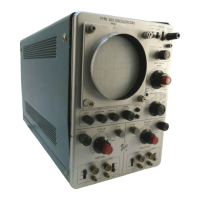
Do you have a question about the Tektronix 503 and is the answer not in the manual?
| Type | Oscilloscope |
|---|---|
| Input Impedance | 1 MΩ |
| Input Capacitance | 47 pF |
| Display | CRT |
| Power Supply | 115/230 V AC, 50-60 Hz |
Overview of the characteristics section.
Details specifications for vertical and horizontal amplifiers.
Specifications related to the sweep generator.
Specifications for the triggering system.
Specifications for the built-in calibrator.
Specifications for the cathode ray tube display.
Specifications for the instrument's power requirements.
Physical dimensions and construction details.
Information on available accessories.
General information on using the oscilloscope.
Details on voltage and frequency requirements.
Information on required fuses.
Description of front/rear panel controls and connectors.
Step-by-step guide for initial setup.
How to operate in standard oscilloscope mode.
Explanation of sweep triggering for stable display.
How to select trigger source, coupling, and slope.
How to adjust the trigger level control.
Explanation of automatic and free-running trigger modes.
How to use the sweep magnification feature.
How to use the instrument in X-Y mode.
Examples of measurement applications.
Procedures for measuring AC and DC voltages.
Procedures for measuring time intervals and frequency.
Procedures for measuring phase shift.
How to connect signals directly to CRT plates.
How to select inputs and signal coupling.
Overview of circuit analysis.
Detailed description of the vertical amplifier.
Description of the output amplifier stage.
Detailed description of the horizontal amplifier.
Description of the sweep trigger circuit.
Explanation of the sweep generation process.
Explanation of automatic triggering operation.
Description of the CRT circuit.
Description of the calibrator circuit.
Description of the power supply circuit.
Overview of maintenance procedures.
Routine maintenance tasks.
Procedures for fixing issues.
How to order replacement parts.
Steps for removing instrument panels.
Guidance for diagnosing and fixing problems.
Techniques for isolating faulty circuits.
Troubleshooting steps for a missing display spot or trace.
Steps for diagnosing power supply issues.
Identifies vertical amplifier as cause of deflection issues.
Diagnosing sweep generator vs. horizontal amp issues.
Checking and diagnosing nonlinear sweep.
Troubleshooting sweep timing issues.
Locating specific faulty stages within circuits.
Purpose of performance checks.
List of necessary equipment for checks.
General and preliminary setup instructions.
Step-by-step guide for verifying instrument performance.
Checks for focus and astigmatism controls.
Checks for vertical and horizontal DC balance.
Checks for CRT trace alignment and geometry.
Checks for amplifier gain and variable control ratios.
Checks for signal compression, expansion, and amplifier balance (CMRR).
Checks accuracy of attenuator circuits.
Checks amplifier phasing and frequency response.
Checks sweep stability, triggering, and timing accuracy.
Checks sweep magnifier accuracy and jitter.
Checks Z-axis operation and calibrator functions.
Purpose and necessity of calibration.
List of equipment needed for calibration.
Specific calibration fixtures required.
Index and record-keeping for calibration steps.
Steps for calibrating power supply voltages.
Calibration steps for CRT alignment and geometry.
Steps for calibrating amplifier gains and balance.
Calibration for attenuator compensation and amplifier phasing.
Calibration steps for sweep stability and triggering.
Checks for calibrator accuracy, symmetry, frequency, and jitter.
Reference to abbreviations and symbols for parts list.
Information required when ordering replacement parts.
Explanation of special symbols used in parts list.
Explanation of indentation in the mechanical parts list.
How to order replacement parts.
Reference to abbreviations and symbols.
Section dedicated to mechanical parts.
Illustration of front panel mechanical parts.
Illustration of switch mechanical parts.
Illustration of CRT shield mechanical parts.
Illustration of chassis and rear mechanical parts.
Illustration of cabinet mechanical parts.
Illustration of standard accessories.
Updates and corrections to the electrical parts list.
Corrections made to schematic diagrams.
Specific corrections for the vertical amplifier schematic.
Specific corrections for the horizontal amplifier schematic.
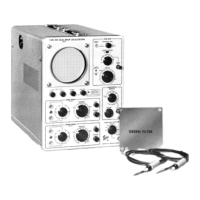
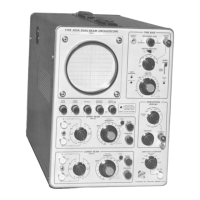


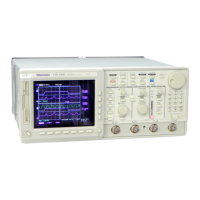




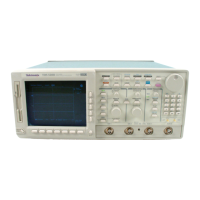
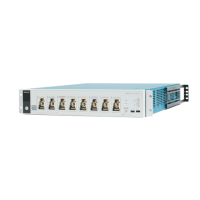
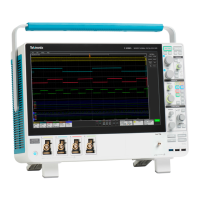
